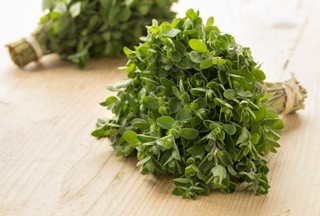Everything you need to know about growing marjoram indoors

Marjoram is one of the most versatile of the fragrant, aromatic culinary herbs. This tender perennial is also easy to grow indoors in a container, making it a no-brainer for anyone who wants fresh marjoram on-demand, right on a sunny indoor windowsill.
What is Marjoram?
Marjoram (origanum majorana) is a tender perennial Mediterranean plant with culinary and medicinal applications. The marjoram plant spreads like a ground cover and has small, oval, light green leaves. Used since ancient times, the Greeks and Romans considered this aromatic herb a symbol of love and happiness, and it was used in love spells. marjoram growing on a grave was considered an auspicious sign of happiness in the afterlife.

History of Marjoram
Classically, marjoram has been used medicinally as a tea for its sedative and as an oil for its antiseptic properties. It is useful as a digestive aid and can also be used externally as an essential oil to apply to bruises, sprains, and inflamed tissues. Marjoram is loaded with calcium, phosphorus, magnesium, and potassium, and contains vitamins A and C. Studies indicate that the high levels of antioxidants in marjoram may be useful for protecting the liver (1) and regulating the cycles of women with polycystic ovary syndrome.(2)
Culinary Uses
The pungent leaves of marjoram have a fresh, bitter, slightly spicy flavor and a fragrance somewhere between basil and thyme. It is drought-tolerant, which makes it a forgiving herb for beginners starting their first indoor herb garden. While considered a perennial herb, most marjoram is grown as an annual because it cannot withstand freezing temperatures. It can, however, be grown as a perennial indoors.
Marjoram leaves can be used chopped, whole, fresh, or dried in compound butter, meat dishes, omelets, sauces, salads, garnishes, marinades, salad dressings, and soups. It is one of the major components in the French herbes de Provence blend and is featured heavily in Thanksgiving stuffing. While it is used interchangeably with oregano, it has a much sweeter, milder flavor which gives it great culinary versatility.
Types of Marjoram
All Origanum plants are part of the mint family.(3) There are three types of marjoram: sweet marjoram, pot marjoram, and wild marjoram (known as common oregano). All types of marjoram are equally straightforward to grow and have similar properties, but sweet marjoram is the mildest variety with the best flavor for using in a wide range of dishes.


The enthusiast's guide to herbs
We’re proud to present our new e-book, The Enthusiast’s Guide to Herbs! Learn everything you need to know about growing and caring for herbs indoors, including in-depth info cards for the 35 most commonly grown herbs.
Click the link below to find out more!
How to grow Marjoram
What you will need
- A pot that is at least 8" in diameter that has good drainage
- A drainage tray to put beneath the pot
- A rich, high-quality potting mix
- Marjoram seeds or access to a marjoram plant
- A location that receives full sun
Growing Conditions
Originating in the Mediterranean, marjoram is well suited to a hot, sunny, and arid environment, which means that it is well adapted for indoor container gardening. Marjoram needs bright light–so place it on the sunniest windowsill you have, or in a window box planter with southern exposure.
Container and Soil Type
Because of marjoram’s tendency to trail, it will need the right container and potting soil to perform optimally as an indoor herb. A pot that is both shallow and wide will provide the surface area to give your plant space to spread out. Potting mixes with good drainage designed for cacti or succulent plants will serve your marjoram well. You could also create a DIY soil blend using equal parts soil and decomposed granite with added perlite or peat moss for increased drainage.
Light Requirements
Marjoram requires a lot of light, a minimum of six hours of direct sun per day. If there is no suitable location in your home, you may want to invest in a supplemental fluorescent or LED grow light. Make sure that any supplemental lighting is set up about six inches above the plant and set on a timer to stay on for twelve hours a day. If you have a sunny outdoor patio, you can place your pot on it during the summer, just be mindful of pests.
Growing from seed
For the best results, plan to sow seeds six to eight weeks before the last frost, in early spring. Fill your container of choice with soil to about one inch from the top. Broadcast a pinch of marjoram seeds over the surface of the soil, taking care to distribute them as evenly as possible. Water with a watering can so that the soil is completely moist, and don’t worry about the seeds being moved around–they are very tiny and the displacement of the soil by the water will help to cover them with a thin layer of soil.
Cover the pot with cling wrap or plastic and place them in a well-lit windowsill to germinate. Within a week or two, you should see the first sprouts beginning to emerge. Give them a couple of weeks to grow, and then pluck out all but the healthiest few plants you want to keep.
Growing from cuttings
Growing marjoram from cuttings is simple. Find a mature plant and trim off up to a half dozen stems at least six inches long. Pluck the leaves from the bottom inch or so of the stems, dip them into rooting hormone, and then plant in pre-moistened soil. You may want to use a chopstick to make a hole for each stem and then gently nestle the soil around it once it’s been inserted.
This is the only time you will ever want to keep the soil of a marjoram plant consistently moist for any period of time. If you use a transparent container for this stage, you can see when the roots have extended to the edge, or you can plant in a small four-inch plastic pot and wait until you see roots coming out of the drainage slots at the bottom. At this point, transplanting the plant to a larger pot is ideal.

Basic Marjoram Care
Marjoram is low-maintenance and drought-resistant. The best watering policy is to wait until the soil surface is completely dry before watering. Fertilization may be necessary after a year or so in the same soil, but for the most part, it is not necessary. If you notice the growth of your plant slowing down (outside of late winter, which is normally a time of slower growth), you can apply a top dressing of compost, fish emulsion, or diluted liquid fertilizer to the soil surface.
Once your plants are around six inches tall, begin pinching the tips off to encourage dense, bushy growth. Harvesting from the tips like this continuously will ensure strong, healthy growth. Marjoram can be susceptible to aphids and spider mites, so always keep a close eye on your plants to make sure they are free and clear of pests. If they do get infected, treat them with neem oil periodically until they are free of pests.
Harvesting and Storing
Marjoram is easy to harvest, just wait until your plants are four inches or so tall before you begin. In the beginning, you will be able to easily pinch sprigs off with your fingernails, but as the plant grows more woody and mature you should use scissors to avoid damaging the plant when you harvest. Always harvest just above a growth node (where two leaves meet), to encourage growth. Wherever you cut one stem, two new stems will grow. The more often you harvest, the bushier and more robust your plant will be.
In late summer, your plant may put out flower buds. Do your best to harvest as much growth as possible when you see buds forming because the flavor is at its best right at this point. You can cut up to 2/3 of the plant at once without damaging it at all. When you make a big harvest, consider drying or preserving your fresh marjoram for later.
Conclusion
There is scarcely a savory dish that doesn’t benefit from the addition of a little marjoram. Having a pot of marjoram on a sunny windowsill should encourage you to experiment with its delicious, pungent flavor in dishes you might not have otherwise. Even if this is your maiden voyage into indoor gardening, you’ll find marjoram to be forgiving, undemanding, and delicious.

Join our email club—get printable info cards free!
Sign up to receive our newsletter and get access to 10 printable plant info cards from our e-book for free. Also receive:
- $4 discount code for our Guide to Herbs e-book
- Semi-weekly plant inspiration & bite-size tips and tricks
